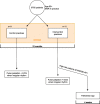The effect of a case-finding app on the detection rate of atrial fibrillation compared with opportunistic screening in primary care patients: protocol for a cluster randomized trial
- PMID: 34372905
- PMCID: PMC8351454
- DOI: 10.1186/s13063-021-05497-x
The effect of a case-finding app on the detection rate of atrial fibrillation compared with opportunistic screening in primary care patients: protocol for a cluster randomized trial
Abstract
Background: Atrial fibrillation is a cardiac arrhythmia commonly encountered in a primary care setting. Current screening is limited to pulse palpation and ECG confirmation when an irregular pulse is found. Paroxysmal atrial fibrillation will, however, still be difficult to pick up. With the advent of smartphones, screening could be more cost-efficient by making use of simple applications, lowering the need for intensive screening to discover (paroxysmal) atrial fibrillation.
Methods/design: This cluster randomized trial will examine the effect of using a smartphone-based application such as FibriCheck® on the detection rate of atrial fibrillation in a Flemish general practice population. This study will be conducted in 22 primary care practices across the Flanders region of Belgium and will last 12 months. Patients above 65 years of age will be divided in control and intervention groups on the practice level. The control group will be subjected to standard opportunistic screening only, while the intervention group will be prescribed the FibriCheck® app on top of this opportunistic screening. The difference in detection rate between control and intervention groups will be calculated at the end of the study. We will use the online platform INTEGO for pseudonymized data collection and analysis, and risk calculation.
Discussion: Smartphone applications might offer a way to cost-effectively screen for (paroxysmal) atrial fibrillation in a primary care setting. This could open the door for the update of future screening guidelines.
Trial registration: ClinicalTrials.gov NCT04545723 . Registered on September 10, 2020.
Keywords: Atrial fibrillation; Case finding; FibriCheck®; Screening.
© 2021. The Author(s).
Conflict of interest statement
TP is an employee of Qompium, the company that provides the FibriCheck® app. The other authors declare that they have no competing interests.
Figures
Similar articles
-
[Mobile health for detection of atrial fibrillation-Status quo and perspectives].Internist (Berl). 2022 Mar;63(3):274-280. doi: 10.1007/s00108-022-01267-2. Epub 2022 Feb 11. Internist (Berl). 2022. PMID: 35147711 Free PMC article. Review. German.
-
Opportunistic screening versus usual care for detection of atrial fibrillation in primary care: cluster randomised controlled trial.BMJ. 2020 Sep 16;370:m3208. doi: 10.1136/bmj.m3208. BMJ. 2020. PMID: 32938633 Free PMC article. Clinical Trial.
-
A randomised controlled trial and cost-effectiveness study of systematic screening (targeted and total population screening) versus routine practice for the detection of atrial fibrillation in people aged 65 and over. The SAFE study.Health Technol Assess. 2005 Oct;9(40):iii-iv, ix-x, 1-74. doi: 10.3310/hta9400. Health Technol Assess. 2005. PMID: 16202350 Clinical Trial.
-
Detecting and Diagnosing Atrial Fibrillation (D2AF): study protocol for a cluster randomised controlled trial.Trials. 2015 Oct 23;16:478. doi: 10.1186/s13063-015-1006-5. Trials. 2015. PMID: 26499449 Free PMC article. Clinical Trial.
-
Wearables, Smartphones and Novel Anticoagulants: We Will Treat More Atrial Fibrillation, but Will Patients Be Better Off?J Gen Intern Med. 2016 Nov;31(11):1367-1368. doi: 10.1007/s11606-016-3761-8. Epub 2016 Jun 23. J Gen Intern Med. 2016. PMID: 27338593 Free PMC article. Review.
Cited by
-
Samen sterk door persoonsgerichte en digitale zorg.Huisarts Wet. 2022;65(4):14-18. doi: 10.1007/s12445-022-1423-0. Epub 2022 Mar 14. Huisarts Wet. 2022. PMID: 35309971 Free PMC article. Dutch.
-
[Mobile health for detection of atrial fibrillation-Status quo and perspectives].Internist (Berl). 2022 Mar;63(3):274-280. doi: 10.1007/s00108-022-01267-2. Epub 2022 Feb 11. Internist (Berl). 2022. PMID: 35147711 Free PMC article. Review. German.
References
-
- Department of Public Health and Primary Care, KU Leuven. INTEGO Project. 2011. [online], [https://intego.be].
Publication types
MeSH terms
Associated data
LinkOut - more resources
Full Text Sources
Medical


